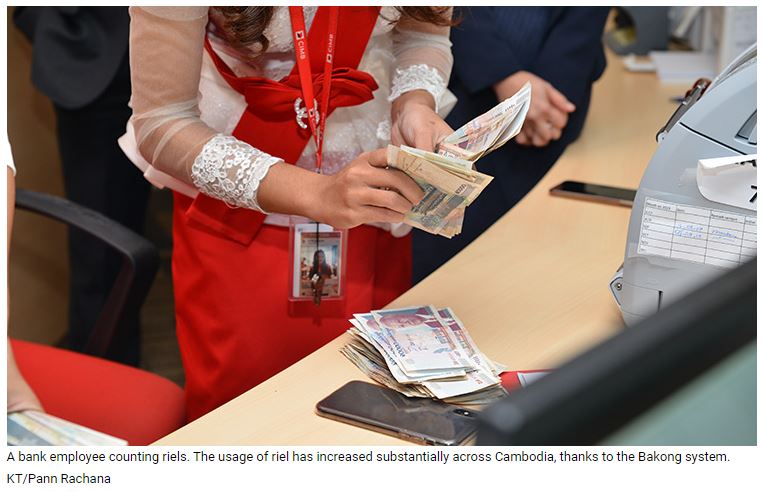Cambodia: Payment in riel grew faster than US dollar through Bakong
The amount of cash paid in riel by account holders through Bakong system has increased 4.1 times in 2022 compared to the previous year, while that paid in US dollar through the same system has risen 3.2 times, and the transactions made through this system have surged 2.2 times to 26.1 million, according to an annual report issued by National Bank of Cambodia (NBC).
The NBC’s Annual Report 2022 shows that 0.52 million accounts were created by financial service consumers to use Bakong system initiated by the NBC for banking and financial service consumers to make payment via the country’s only all-in-one mobile payment and banking application. Bakong has 69 banks and financial institutions as members and has been launched officially by 46 of those institutions.
Bakong, which was launched by the NBC in 2020, redefines mobile payment and banking by combining e-wallets, mobile payments, online banking and financial applications within one easy-to-use interface for any preferred bank account. With Bakong system, banking and financial service consumers would stop switching between apps today and enjoy unrivalled simplicity, convenience and security.
Users can enjoy the most convenient access to Bakong and perform transactions with dual log-in options—PIN Code or Biometric-fingerprint. Those transactions include sending-receiving funds, making payments in Khmer riel or US dollar, placing deposits to bank accounts, viewing transaction history and setting personal limit.
Chea Serey, NBC’s Deputy Governor, said the Bakong system is a backbone payment system where its development is to serve the main objectives such as enabling interoperability between institutions, enhancing the efficiency and security for a payment system, and promoting financial inclusion and the use of cashless riels.
Serey pointed out that the Royal Government of Cambodia and NBC have introduced riel promotion policies, especially since the early 2000s after the country’s macroeconomic stability has been in a great position, which have increased the use of riel in the circulation. Among those policies, electronic payment—Bakong—has been developed subsequently to promote easy, safe and efficient payment of riel in the economy.
Bakong has been developed with the latest technology so-called blockchain, which is a database that stores information electronically in digital format. The goal of blockchain is to allow digital information to be recorded and distributed, but not edited. In this way, a blockchain is the foundation for immutable ledgers, or records of transactions that cannot be altered, deleted, or destroyed.
“I would like to point out that we have done a survey to ask our people of the reason why they do not want to spend with riel. Most of them responded that spending with dollar is easier as it has less zero numbers and sometimes, they needed to take a big bag with riel banknotes to pay for a product, which means it is difficult as our banknote’s value is low,” Serey said.
Serey further said the NBC had prepared legal frameworks that allow private banks, financial institutions and microfinance institutions to develop and launch their respective mobile banking applications for their customers to download in their mobile phones.
NBC has developed a system that connects all those institutions’ mobile applications to one another to encourage people to use electronic payments more and more. “Now, they would not complain … like that as they just hold a mobile phone to make payment by just pressing number zero a few or several times and then payment can be made,” Serey said.
Bakong system also enables users to make payments or transfers from one institution to another on mutual mode without being charged even though they have accounts at different institutions. “The system does not mind the same institutions and so it provides easiness for users,” said the senior official of Cambodia’s central bank.
The Economic and Monetary Statistics for November 2022 issued by the NBC shows that deposits in riel rose to 11 percent of total deposits in all currencies in November last year, while deposits in US dollar and other foreign currencies fell to 89 percent, which contributed 50.3 percent by fixed or term deposits, 19.8 percent as current deposits, 28.5 percent as savings deposits and 1.5 percent as other categories of deposits.
The statistics report also shows that the interest rates—average weighted according to banking transactions for the new loans in November—for loans in US dollar and riel provided by banks fell by 0.2 percent to 8.85 percent per annum and 0.57 percent to 10.89 percent per annum, respectively, while the weighted average interest rate for deposits in riel rose by 0.03 percent to 0.89 percent per annum, but that in US dollar fell by 0.11 percent to 0.49 percent per annum.
Source: https://www.khmertimeskh.com/501276160/payment-in-riel-grew-faster-than-us-dollar-through-bakong-2/


 Thailand
Thailand




